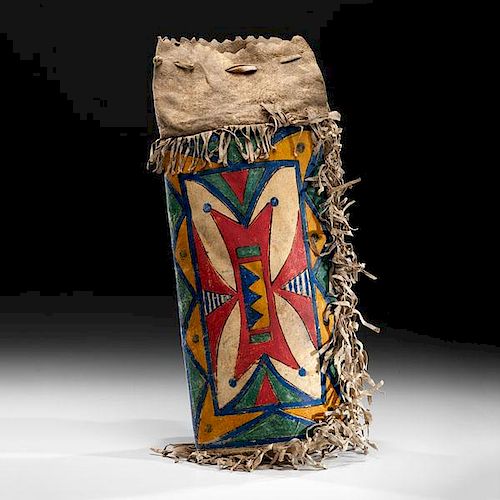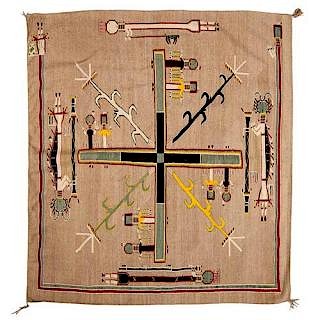Sioux Polychrome Parfleche and Hide Bag from the William H. Jensen Collection (ca 1887-1979), Minnesota
About Seller
6270 Este Ave.
Cincinnati , OH 45232
United States
With offices in Cincinnati, Cleveland and Denver, Cowan’s holds over 40 auctions each year, with annual sales exceeding $16M. We reach buyers around the globe, and take pride in our reputation for integrity, customer service and great results. A full-service house, Cowan’s Auctions specializes in Am...Read more
Two ways to bid:
- Leave a max absentee bid and the platform will bid on your behalf up to your maximum bid during the live auction.
- Bid live during the auction and your bids will be submitted real-time to the auctioneer.
Bid Increments
| Price | Bid Increment |
|---|---|
| $0 | $25 |
| $500 | $50 |
| $1,000 | $100 |
| $2,000 | $250 |
| $5,000 | $500 |
| $10,000 | $1,000 |
| $20,000 | $2,500 |
| $50,000 | $5,000 |
| $100,000 | $10,000 |
About Auction
Sep 25, 2015 - Sep 26, 2015
Cowan's Auctions dawnie@cowans.com
- Lot Description
Sioux Polychrome Parfleche and Hide Bag from the William H. Jensen Collection (ca 1887-1979), Minnesota
parfleche painted on both sides with differing geometric designs in colors of red, blue, yellow, and green with thin back outlining; hide fringe, base, and throat are sinew-sewn, length 24 in. x width 10.25 in.
early 20th century
William H. Jensen (ca 1887-1979)
In 1933, while laying gravel for his driveway, W. H. Jensen discovered bone fragments and a stone tool, prompting him to investigate further. After several hours of sifting through the gravel, he found more bone fragments belonging to a man dated roughly 9,000 years old, a date confirmed by the lithic flaked tools discovered at the site. The Browns Valley Man was a Paleo-Indian, considered to be of the first people to arrive in the Americas from Asia (though debate on their exact routes and dates is ongoing). During that same time it is believed that Browns Valley was a Paleo-Indian burial site, one of few in the country and the only one in Minnesota. In 1934, it was investigated by A. E. Jenks, University of Minnesota.
Jensen was born in 1887 on an island in Lake Traverse (Jensen's island) and was hunting for arrowheads in the family garden by age 5. He began his vocation as a teacher to the Sisseton Indians of South Dakota which lead to many other business adventures. Throughout his careers, he was known in the community for buying ethnographic material his entire life.
William H. Jensen (1886-1960)
Jensen was born in St. Paul, MN. By age 7, he was hunting for arrowheads in the family garden on Jensen’s Island in Lake Traverse, near Browns Valley, MN. As a young adult Jensen became committed to understanding the heritage of the Browns Valley area. He worked first as a teacher; later, as a worker and then owner of the Browns Valley grain elevator; and finally, as the owner of the first TV tower in Browns Valley. Despite his busy schedule and his family life, Jensen always found time to work as an amateur archaeologist. Before long he was known for both his excavations and his ethnographic collection.
Jensen’s enthusiasm for anthropology and his discerning eye led to an important accidental discovery. In 1933, when a load of gravel was delivered to his grain elevator, Jensen discovered human bone fragments and a stone tool buried in the gravel. He hurried to the pit, which was located within the city limits in the Plateau Addition of Browns Valleys. With the help of the driver he found the site and began carefully sifting through more gravel, where he discovered additional bones and some flaked-stone tools.Jensen contacted Albert E. Jenks from the University of Minnesota and, in time, dating tests confirmed that the skeletal material was approximately 9,000 years old. This Paleo-Indian skeleton has become known as the Browns Valley Man, most likely he was one of the first Indians to arrive in the Americas from Asia. Brown’s Valley is one of the oldest sites in North America."
Provenance: Property of a Minnesota Collector; Ex William H. Jensen (1886-1960) CollectionCondition requests can be obtained via email (danica@cowans.com) or by telephone (513-871-1670). Any condition statement given, as a courtesy to a client, is only an opinion and should not be treated as a statement of fact. Cowan's Auctions shall have no responsibility for any error or omission.Condition
- Shipping Info
-
SHIPPING. At the request of the buyer, Cowan's will authorize the shipment of purchased items. Shipments usually occur within two weeks after payment has been received. Shipment is generally made via UPS Ground service. Unless buyer gives special instructions, the shipping method shall be at the sole discretion of Cowan's Auctions, Inc.. Cowan's is in no way responsible for the acts or omissions of independent handlers, packers or shippers of purchased items or for any loss, damage or delay from the packing or shipping of any property.
-
- Buyer's Premium



 EUR
EUR CAD
CAD AUD
AUD GBP
GBP MXN
MXN HKD
HKD CNY
CNY MYR
MYR SEK
SEK SGD
SGD CHF
CHF THB
THB













